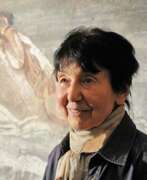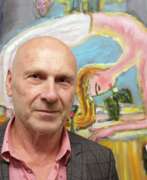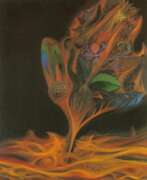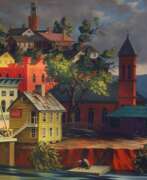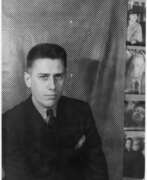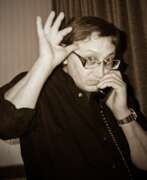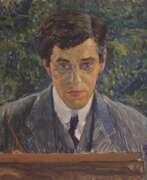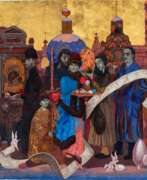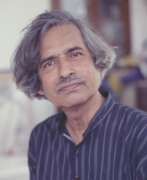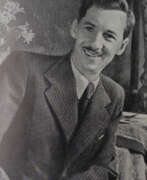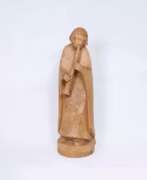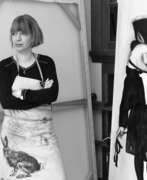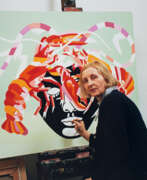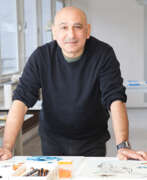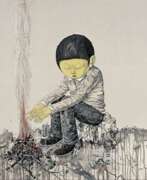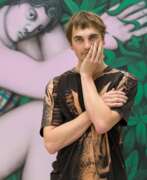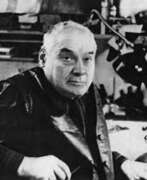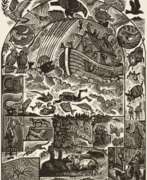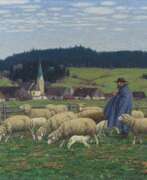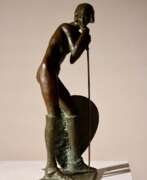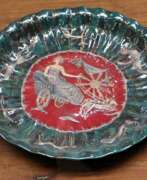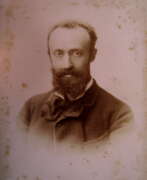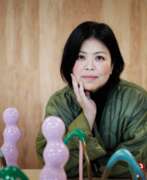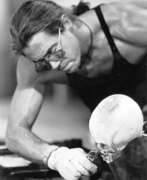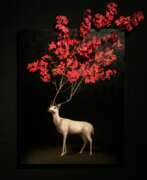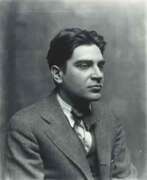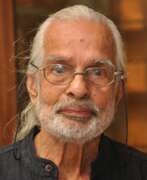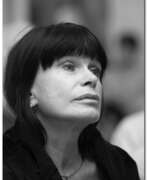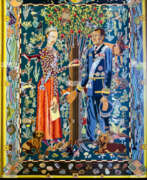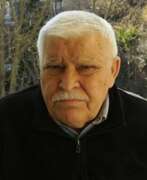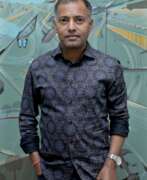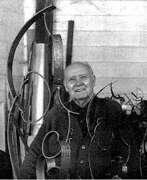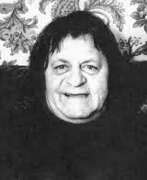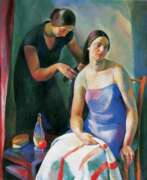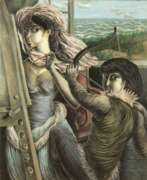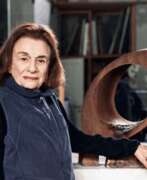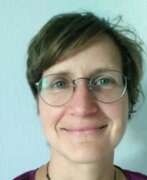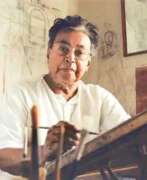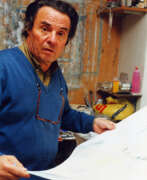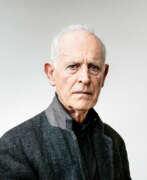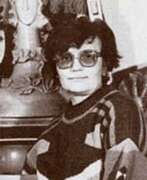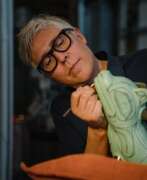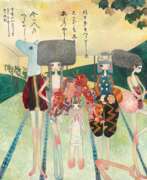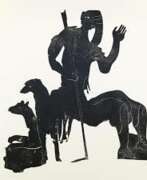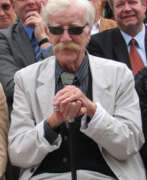Mythological painting Contemporary art
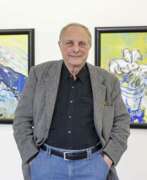

Christian Ludwig Attersee, born Christian Ludwig, is an Austrian media artist living in Vienna and Semmering in Lower Austria.
The artist took his middle name, Attersee, from the area where he spent his youth. He studied at the Vienna Academy of Applied Arts and his work was characterized early on by flamboyant sexualization. He is known not only as a visual artist, but also as a musician, writer, object artist, designer, stage designer and film director. In the 1960s and 1970s he also created series on themes of food, everyday objects, beauty and cosmetics.
Attersee is known above all as one of the leading representatives of objective painting in Europe in the last 50 years. In the second half of the seventies he became the founder of the "New Austrian Painting". From 1990 to 2009, Atterse held a chair at the Vienna University of Applied Arts.
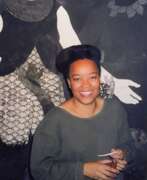

Belkis Ayón was a Cuban printmaker who specialized in the technique of collography. Ayón created large, highly-detailed allegorical collographs based on Abakuá, a secret, all-male Afro-Cuban society. Her work is often in black and white, consisting of ghost-white figures with oblong heads and empty, almond-shaped eyes, set against dark, patterned backgrounds.
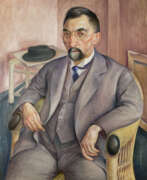

Albert Birkle was a German and Austrian painter, decorator, muralist and glass painter.
Albert's father was the artist Karl Birkle, from whom he received his initial training as a decorative painter, then studied at the Hochschule für die bildenden Künste (now the Berlin University of the Arts). Birkle developed a unique style based on Expressionism and the New Objectivity/Neue Sachlichkeit style. His subjects were lonely, mystical landscapes, typical scenes of Berlin in the 20s and 30s, portraits and religious scenes.
In 1932, fleeing the National Socialists, Albert Birkle moved to Salzburg, Austria, but nevertheless represented Germany at the Venice Biennale as early as 1936. In 1937, his work was declared "degenerate" in Germany and withdrawn from state collections. In 1946, Birkle was granted Austrian citizenship and began working on religious frescoes and decorative windows for various churches and oil paintings. The 1950s and 60s were filled with intense creativity in glass painting.
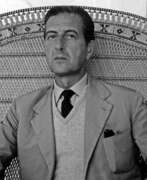

Fabrizio Clerici was an Italian painter, draftsman, illustrator, scenographer and architect.
Clerici earned a degree in architecture and was greatly influenced by antiquities, Renaissance and Baroque painting and architecture. In 1943, Clerici held his first solo exhibition at the Galleria dell'Arte Cairola in Milan, featuring drawings, watercolors, lithographs and etchings. His first book illustrations belong to the same period.
In 1947, Clerici began a prolific career in theater, ballet and opera with his debut as a stage designer in a production of George Bernard Shaw's play Mrs. Warren's Profession. The following year he participated for the first time in the Venice Biennale. There he met Salvador Dalí and created the sets and costumes for Igor Stravinsky's Orpheus, which was performed at the La Fenice Theater. In 1949 he created large-scale architectural fantasy paintings.
The further life of the multifaceted artist Fabrizio Clerici was full of work in a variety of fields of art, creative successes and exhibitions. His work has been exhibited in many museums in the United States, including MoMA and the Guggenheim Museum, as well as in France, such as the Pompidou Center.
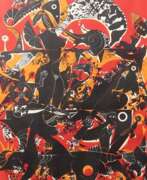

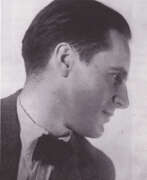

Marc Eemans was a Belgian painter, poet and art historian, one of the pioneers of constructivist abstraction.
In 1925, Eemans joined the Surrealist artists Dali and Magritte, with whom he held joint exhibitions. And soon the poet's fame eclipsed his success as a painter. In 1930, Eemans made his debut as a poet in Vergeten te worden: 10 lijnvormen, beïnvloed Door 10 woordvormen. Influenced by Symbolism, he calls his poetry "gnostic surrealism". In 1938 he publishes a collection of poems, Visioen Woli, and others.
His artistic and political stance during World War II led to a break with Magritte and others.
In addition to poetry collections, Eemans wrote essays on a variety of subjects, including modern painting and architecture.
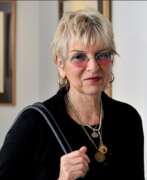

Audrey L. Flack is an American artist. Her work pioneered the art genre of photorealism and encompasses painting, sculpture, and photography. Flack's early work in the 1950s was abstract expressionist. But gradually, Flack became a New Realist and then evolved into photorealism during the 1960s. Audrey Flack is best known for her photo-realist paintings and was one of the first artists to use photographs as the basis for painting.[6] The genre, taking its cues from Pop Art, incorporates depictions of the real and the regular, from advertisements to cars to cosmetics. Flack's work brings in everyday household items like tubes of lipstick, perfume bottles, Hispanic Madonnas, and fruit.[6] These inanimate objects often disturb or crowd the pictorial space, which are often composed as table-top still lives. Flack often brings in actual accounts of history into her photorealist paintings, such as World War II' (Vanitas) and Kennedy Motorcade. Women were frequently the subject of her photo-realist paintings. She was the first photorealist painter to be added to the collection of the Museum of Modern Art in 1966.
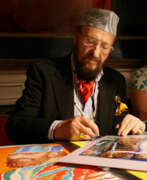

Ernst Fuchs was an Austrian painter, draftsman, printmaker, sculptor, architect, stage designer, composer, poet, and one of the founders of the Vienna School of Fantastic Realism. In 1972, he acquired the derelict Otto Wagner Villa in Hütteldorf, which he restored and transformed. The villa was inaugurated as the Ernst Fuchs Museum in 1988.


Mariann Grunder, or Susie Mariann Grunder, was a Swiss artist and sculptor. She created large wall reliefs with concrete elements. And her stone sculptures, which often deal with literary or mythological themes, combine elements of surrealism, abstraction and minimalism. Grunder has also done numerous drawings and prints.


Ulrich Hachulla is a German painter and graphic artist, representative of the New Objectivity movement, who lives and works in Leipzig.
He was educated at the Academy of Fine Arts in Leipzig and, in addition to painting, has mastered many graphic techniques.
Hahulla's portraits and self-portraits depict a man in solitude, unsociable, coldly detached - these are numerous types of the respective times. The artist also creates paintings with mythological and allegorical references.
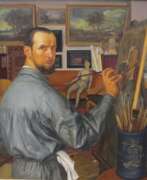

Aleksandr Evgenevich Iakovlev (Russian: Александр Евгеньевич Яковлев), a Russian painter, graphic artist, and designer, left an indelible mark on the world of art with his unique blend of classical and orientalist styles. Born in Saint Petersburg, Russia, in 1887, Iakovlev was part of the vibrant Russian artistic community that contributed significantly to the neo-classical and orientalist movements. His extensive travels across Mongolia, China, Japan, Africa, Syria, Iran, and Afghanistan enriched his art, leading to a prolific output of portraits, landscapes, still lifes, and figure compositions that combined elements of Italian Renaissance with Russian Primitivism.
Iakovlev's early involvement with the Mir Iskusstva exhibition in 1915 showcased his talent but also highlighted the mixed reactions from critics and the Academy of Arts, signaling his departure from traditional academic confines. His scholarship to study in the Far East and subsequent travels profoundly influenced his work, as seen in his orientalist paintings and ethnographic drawings. This period of exploration culminated in his significant contributions as an official artist on the Citroën expeditions across Central Africa and Asia, where he captured the essence of the diverse cultures he encountered.
His works, such as "Three Women in a Box at the Theatre" and his participation in designing the Prival Komediantov artistic cabaret, exemplify his mastery of merging traditional subjects with a modernist touch. Serving as the Director of the Painting Department at the School of the Museum of Fine Arts, Boston, between 1934 and 1937, Iakovlev influenced the art scene beyond the Russian borders before his death in Paris in 1938.
Iakovlev's legacy is preserved in museums and galleries worldwide, celebrating his contributions to bridging cultures through art. His ability to document his travels and experiences in such a vivid and artistic manner has left a lasting impact on the appreciation of cultural diversity in the art world.
For collectors and experts in art and antiques, Aleksandr Evgenevich Iakovlev's works represent a convergence of classical artistry and exploratory zeal, making them highly sought after. His pieces not only capture the beauty of the subjects he portrayed but also serve as a window into the cultures and landscapes that inspired him.
For updates on exhibitions and auction events featuring Aleksandr Evgenevich Iakovlev's works, sign up to stay informed about new discoveries and opportunities to add to your collection.
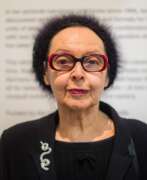

Dorothy Iannone is an American artist who lived and worked in Germany for a long time. Most of Iannone's paintings, texts and films are about erotic love. Freedom, free love, uninhibited sexuality are the central theme of the artist's images.
Yannone's depictions of the human body are largely based on Greek and Oriental motifs, Japanese prints, and the fine art of Tibetan and Indian religions.
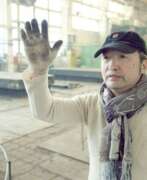

Matsumaro Khan (Russian: Мацумаро Хан), also known as Victor Khan (Виктор Хан), is a Russian sculptor and media artist of Korean descent. His artistic approach is eye-catching, especially when he works with fired and heat-treated materials, which gives his work an unpredictable visual effect. For Matsumaro, fire is not only a tool but also an ally in creating unique works of art.
Tireless in his creativity, Matsumaro experiments with and is inspired by unusual objects such as mugs and pots, creating masterpieces that seem to open the door to an alien world. His work is a perfect blend of tradition and modernity, which makes his art recognizable and in demand both in Russia and abroad.
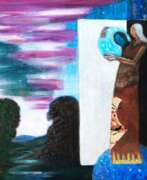

Joseph Losavio is a contemporary American artist who lives and works in rural Sussex County, New Jersey. Raised in the suburbs of central New Jersey, he was fortunate to live in wooded neighborhoods and established an early bond with nature and the outdoors. After earning an undergraduate degree in Psychology from Lafayette College, Easton, PA, he began his artistic career in the Painting and Drawing Department at Pratt Institute in Brooklyn, NY. He chose landscape and personal myth as metaphors for exploring my place in the world. In order to support his creative work, he decided to teach art, initially to mentally challenged adults in a developmental center setting, and later to young children in the New Jersey Public School system. This allowed me to grow artistically, expand my range of interests and earn a Master’s Degree in Painting from William Paterson University, Wayne, NJ. In June 2013, he retired from teaching after 27 years to pursue his painting career full-time.
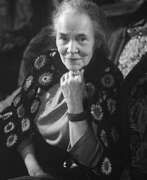

Tatyana Alekseevna Mavrina (Russian: Татьяна Алексеевна Маврина) was a Soviet and Russian artist of the twentieth century. She is known as a painter, graphic artist and illustrator of children's books. Mavrina worked in the genres of portrait, landscape and still life in a style close to primitivism. She boldly experimented with watercolor, gouache and easel graphics.
Tatyana Mavrina is also known as a researcher of folklore. She traveled extensively to distant cities, got acquainted with folk art, made sketches of old architecture. By the drawings of Mavrina later researchers studied the life of the Russian provinces.
For her contribution to the illustration of children's books Mavrina was awarded the State Prize of the USSR, as well as the international literary prize named after HK Andersen. Mavrina's works, as well as her collection of handicrafts are kept in the Russian Museum and the Pushkin Museum.
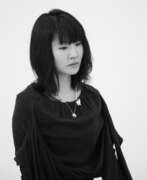

Tomoko Nagai is a Japanese artist who lives and works in Japan.
She graduated from the University of Fine Arts and Music of Aichi Prefecture with a degree in oil painting.
Tomoko Nagai is known for her whimsical, puppet fantasy creatures painted in mixed media. She depicts animals, children, colorful trees and mushrooms as in a theatrical setting. Nagai's most famous work is located in a kindergarten in one of Japan's earthquake-stricken areas, in Shichigahama, Miyagi, where she painted the walls of a swimming pool.
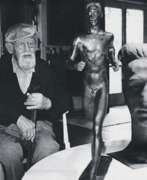

Fritz Nuss is a German painter, sculptor and medalist, as well as a draftsman.
During his long creative life he created many sculptural works of art, which have been recognized at numerous exhibitions around the world. The theme of the sculptor Fritz Nuss's entire life was the human body, which he was able to depict in new facets and poses. His works captivate with purity of lines, monumental language, plasticity of form and a special, chamber emotionality and sensuality. Nuss created both small and large sculptures for public spaces; he designed the Elli-Heuss-Knapp memorial fountain in Stuttgart and many other large sculptures and fountains in Aalen, Freudenstadt, Göppingen, Stuttgart, etc.
Nuss was also a recognized medallist. The works he created can today be found in many famous coin collections around the world. At the end of his life, the half-blind artist, unable to sculpt, created many drawings that just as much praise the beauty of the human body.


Vitaly Nikolayevich Onkov (Russian: Виталий Николаевич Оньков) was a Soviet and Permian Komi artist of the last third of the twentieth and early twenty-first centuries. He is known as a graphic artist and sculptor.
Vitaly Onkov created works reflecting the nature and fauna of the region, as well as elements of Permian Komi pagan and pseudo-Christian mythology. The artist created many paintings and graphic works, including drawings with Permian Komi folk types. He was also one of the authors of the coat of arms and flag of the Permian Komi Autonomous District of the Russian Federation.
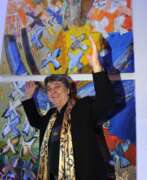

Hans Joachim Pietrula is a German painter, graphic artist and sculptor living in Alsace.
In his watercolors and oil paintings, collages, chalk and glass works, wood and stone engravings and sculptures, Pietrula's decades of creative work never tires of revealing his almost loving admiration for nature and his gentle observation of people. Pietrula loves life, admires nature and celebrates sensuality with vivid colors.
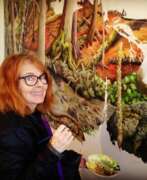

Suzan Lee Pitt was an American film animator and painter, whose surreal, psychological animated films and paintings have been acclaimed and exhibited worldwide.
Throughout the 1980s Pitt designed animated projections for various theatrical projects, in particular two groundbreaking operas in Germany: The Magic Flute for the Staatstheater Wiesbaden in 1983 and The Damnation of Faust for the Staatsoper Hamburg in 1988. In addition, she created large-scale multimedia shows, including a collaboration with John Cage at Harvard University in 1976 and at the Venice Biennale in 1980.
Pitt's honors include a Guggenheim Fellowship in 2000, a Creative Capital Moving Image Award in 2005, a Rockefeller Fellowship, and three production grants from the National Endowment for the Arts. She received a retrospective screening at the Museum of Modern Art in 2017, and a Lifetime Achievement Award at Animafest Zagreb in 2019.
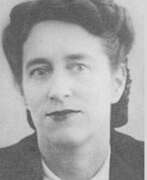

Edith Rimmington was a famous English surrealist painter, poet and photographer. From the beginning to the end of her career, Rimmington was deeply influenced by Salvador Dali. She had an inquisitive mind and boundless imagination and thus became a highly respected and central member of the British Surrealist group. Rimmington also worked with color photographs of coastal landscapes.
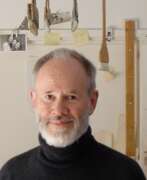

Jörg Schmeisser (Schmeißer) was a German artist who became particularly famous as a graphic artist and engraver. He studied at the Hamburg Academy of Fine Arts, 1962-67, and Kyoto, 1969-72. While studying in Hamburg he studied etching with Paul Wunderlich.
In the 1960s and 1970s he also participated in excavations in Israel and Greece as a draughtsman and travelled to many countries. From 1978 to 1997 he worked at the Canberra School of Art, part of the Australian National University. Jörg Schmeisser was head of the engraving department there.
In 1998 he travelled to Antarctica and stayed at the Australian research stations of Mawson and Davies. The etchings, drawings and paintings he created during this trip have been shown in numerous exhibitions in Australia, Japan, the USA and Germany.
After teaching and working in Jerusalem, Hangzhou, Angkor, Ladakh and Princeton, Jörg Schmeisser took up a professorship at Kyoto City Art University.


Peter Stauss is a German artist, painter and sculptor who lives and works in Berlin. The peculiarity of the artist's works is that they combine important philosophical themes with questions of the genesis of form in painting and sculpture. Stauss' vivid sculptures and paintings combine images from historical, religious and philosophical sources to "recreate the fables of our time."
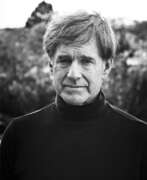

Robert Stivers is an American photographer.
He became interested in photography at a mature age, after a career as a dancer and choreographer. Self-taught in the art of photography, Stivers prides himself on his printing skills. His photographs are printed on matte paper and are often tinted by hand or processed in a darkroom.
The aesthetics of early photography and silent film are evident in Stivers' work, helping the viewer immerse himself in a familiar but distant cultural unconscious. In his technique, the photographer uses defocused images, a blur of movement, to create a hazy vision of the world. In Stivers' photographs, the viewer sees ghostly images of dreams, where objects float and pose, or find themselves caught in the middle of a gesture that reflects his past history in dance.
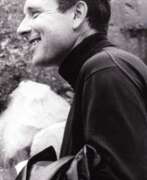

František Štorek was a Czech sculptor.
Štorek's father and uncle owned a forge that supplied ornate Art Nouveau decorative elements, and the future sculptor learned this science from childhood. He studied at the Higher Industrial School of Sculpture and Stonemasonry in Gorzyca and at the Academy of Arts in Prague.
At first Štorek worked with stone and wrought iron, but since 1967 he has been working with bronze and iron sculptures welded from thick plates. He created figures and human torsos in the spirit of magical realism, and interpreted ancient myths. He is the author of the third largest bronze statue in the Czech Republic - Icarus in front of the municipality in Ostrava, and he also sculpted the fountain in the Puchov Vekoše residential complex in Hradec Králové.
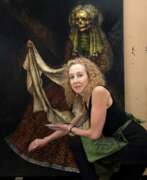

Terry Taylor is an Australian artist, painter and drawer. "I am a painter of death, life and theater," Taylor says of herself. Her classical portraits and figurative compositions follow the ancient tradition of Memento Mori ("Remember Death") and 16th century Dutch Vanitas art; they are a story of life and death, humor and tragedy, truth and lies.
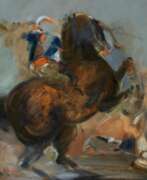

Shonah Trescott is an Australian-born landscape artist who lives and works in New York and Berlin. She is widely known for her paintings that focus on the relationship between people and nature. Shauna Trescott explores the essence of nature, love, fear, and myth, invoking various fields including scientific data, field studies, her personal imagination, and memories.
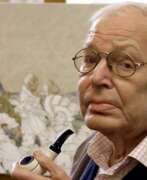

Werner Tübke was a German painter, best known for his monumental Peasants' War Panorama located in Bad Frankenhausen. Associated with the Leipzig School, he is "one of the few East German artists who gained recognition in West Germany."
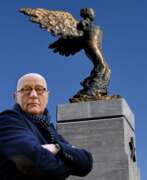

Wil van der Laan is a Dutch painter and sculptor.
His paintings and sculptures are very expressive and dynamic. Wil van der Laan masterfully depicts in his style the tensions of sports moments, the beauty of the Malian peoples, the power of the bulls' movement and the serenity of the resting cheetahs.
The sculptures of van der Laan can be seen not only in private collections, but also in public places in the Netherlands.
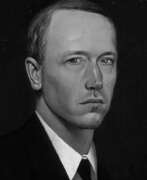

Konstantin Alexeyevich Vasiliev (Russian: Константин Алексеевич Васильев) was a Soviet artist of the mid-twentieth century. He is known as a painter, graphic artist and illustrator, famous for his works on Bylin and mythological themes.
Konstantin Vasiliev was influenced by surrealism and abstract expressionism in the early 1960s, but later shifted to a realist style. He found inspiration in folk art, myths, bylinas, fairy tales, Slavic, Scandinavian and ancient Germanic epics. He also created works dedicated to the Great Patriotic War, landscapes and a series of graphic portraits of composers and musicians.
